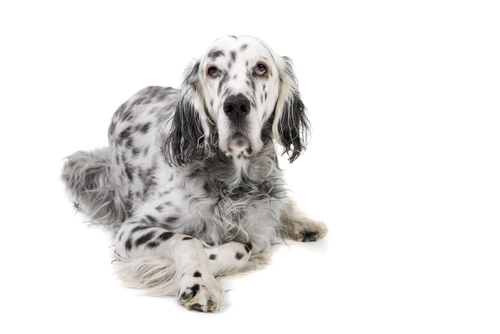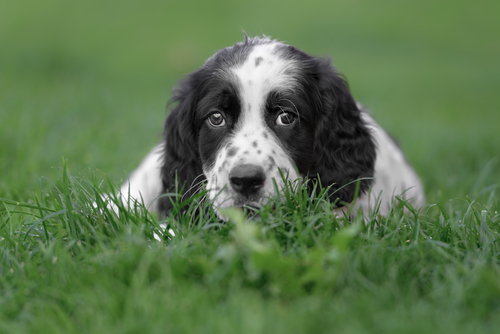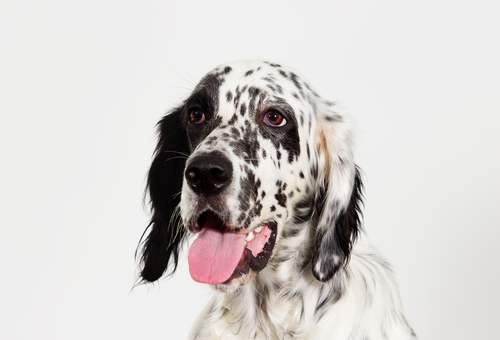
| Kingdom | Animalia |
| Phylum | Chordata |
| Class | Mammalia |
| Order | Carnivora |
| Family | Canidae |
| Genus | Canis |
| Species | Canis lupus |
| Subspecies | Canis lupus familiaris |
| Height | 25-27 in (63-69 cm) |
| Weight | 65-80 lbs (29-36 g) |
| Lifespan | 11-12 years |
| Social Structure | Domesticated |
| Status | Vulnerable Native Breed (American Kennel Club) |
| Natural Habitat | Domesticated, bred for hunting small game birds in open plains |
| Average Litter Size | 6 |
| Main Food Item | Dog Food |
| Potential Predators | Few predators |
The Basics
The English Setter is an elegant, medium-sized domestic dog. It is part of the setter group of breeds, along with others such as the Irish Setter. It is long and lean, with an oval-shaped skull and long muzzle and large, round hazel-colored eyes. Its ears are set back on their heads and hang down to about eye-level. English Setters are primarily white with black or brown markings on their medium-length coat. Some English Setters have long, wavy fringes around their belly, ear and tail while others have generally short hair.

They can weigh up to 80 lbs (36 kg) and stands up to 27 inches (61 cm) tall. Female English Setters typically give birth to about six puppies, which often lack the markings on their white coats that adults have developed. Adults live about 11-12 years.
Although they can be stubborn and mischievous, Setters are intelligent dogs and have a great temperament. They have even been described as ‘Gentlemanly’ and ‘intensely friendly’. English Setters are energetic and people-oriented. As a pet, they are well-suited for families that are able to provide them with a lot of attention and exercise. Having been bred for endurance and athleticism, they are adapted for hunting small game such as quail, pheasant, and grouse that they energetically seek out by scent.

Fun Facts about the English Setter!
Setters have a long history dating back hundreds of years. In fact, when the American Kennel Club was established in 1878, English Setters were among 9 original pure-bred sporting breeds first registered. Indeed, the very first animal registered was a male English Setter named “Adonis”.
Bred for a Purpose
“Setting” dogs were bred to lay down quietly and point (referred to as ‘setting’) to game birds. This breeding history dates back more than 500 years to France, where the first setting strains were developed. These were called “Setting Spaniels”, which would generally crouch when prey was detected so that hunters could throw their nets over the birds. The English Setter developed latter and likely originates from crosses of the Spanish Pointer, Water Spaniel, and English Springer Spaniel breeds. Modern Setters tend to lay down completely rather than crouch. This is a trait that was specifically bred for in response to the advent of firearms that hunters were then using.
Beauty and Brawn
Modern English Setters are not just bred as hunting dogs but have also competed in shows for generations. In fact, show dogs and field dogs tend to have distinct features. Show dogs tend to have long, wispy, fringe fur on their underside, tail, and ears. This hair is referred to as ‘feathering’. Field dogs, in contrast, tend to lack feathering, appearing short-haired somewhat like a Pointer. Field dogs are generally smaller than show dogs with more distinctive spotting as well. It may be this versatility as a breed that has helped it to retain its popularity around the world.

Close but not Quite
It is a common misunderstanding that Irish Setters, Gordon Setters, and English Setters are simply variations of the same breed. Although they all share some features, they are, indeed, separate breeds. However, besides the differences between field dogs and show dogs discussed above, there are different variations of English Setters themselves. These generally refer to the color and frequency of the spots or ‘ticking’ on the dog’s coat. Recognized color variations include ‘blue’, ‘orange’, ‘lemon’ and ‘liver’. As described above, puppies may not display these patters, referred to as ‘belton’ in Setters, until they are grown.
Diversity is Strength
In nature, populations of animals interbreed and emigrate to different habitats. In this way, genetic diversity is maintained, allowing populations to be more resistant to threats such as a disease. If all organisms in a population are identical, they would all be equally susceptible to such threats. In many ways, this is how nature protects the herd.
However, the human domestication of some animals has greatly reduced this genetic diversity. For example, English Setters are often referred to as Laverack’s Setters, after a famous and pioneering breeder of the species. In reality, not all English Setter individuals are Laverack, but only dogs that descend from this particular bloodline.
Ironically, the intense inbreeding that occurred to create such prestigious bloodlines also greatly reduced the genetic diversity of the animals. Many purebred dogs face such challenges. In Laverack English Setters, this has lade to a host of potential health challenges including congenital deafness, autoimmune arthritis, and hip and elbow dysplasia. Without genetic diversity, species are not able to eliminate genetic shortcomings from the gene pool. Instead, inbreeding preserves these characteristics just as it does the positive traits breeders are aiming to achieve.
